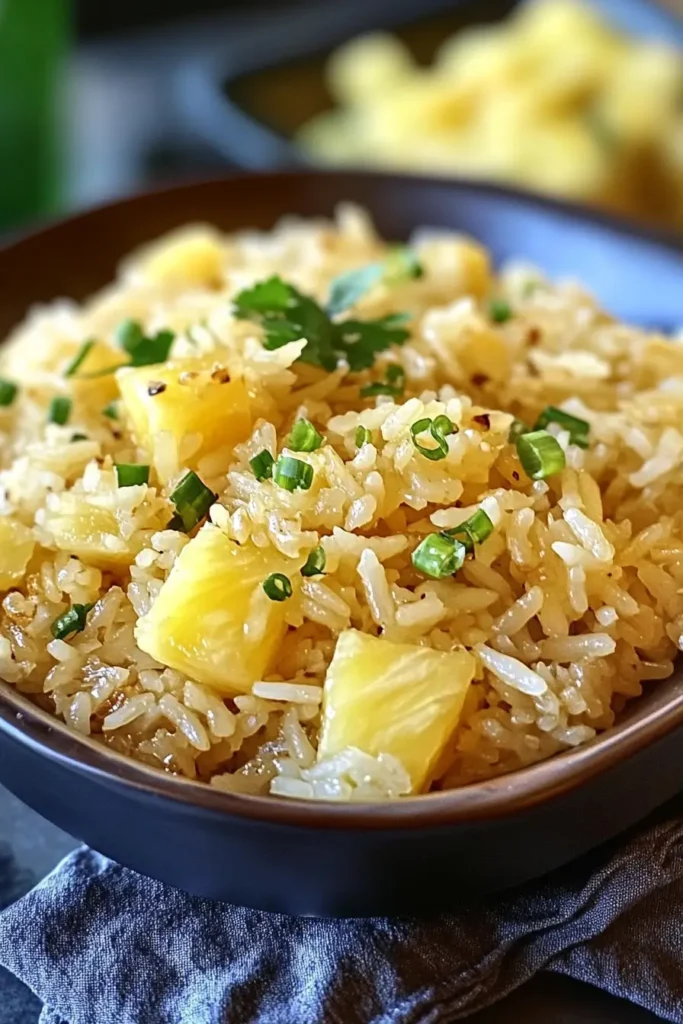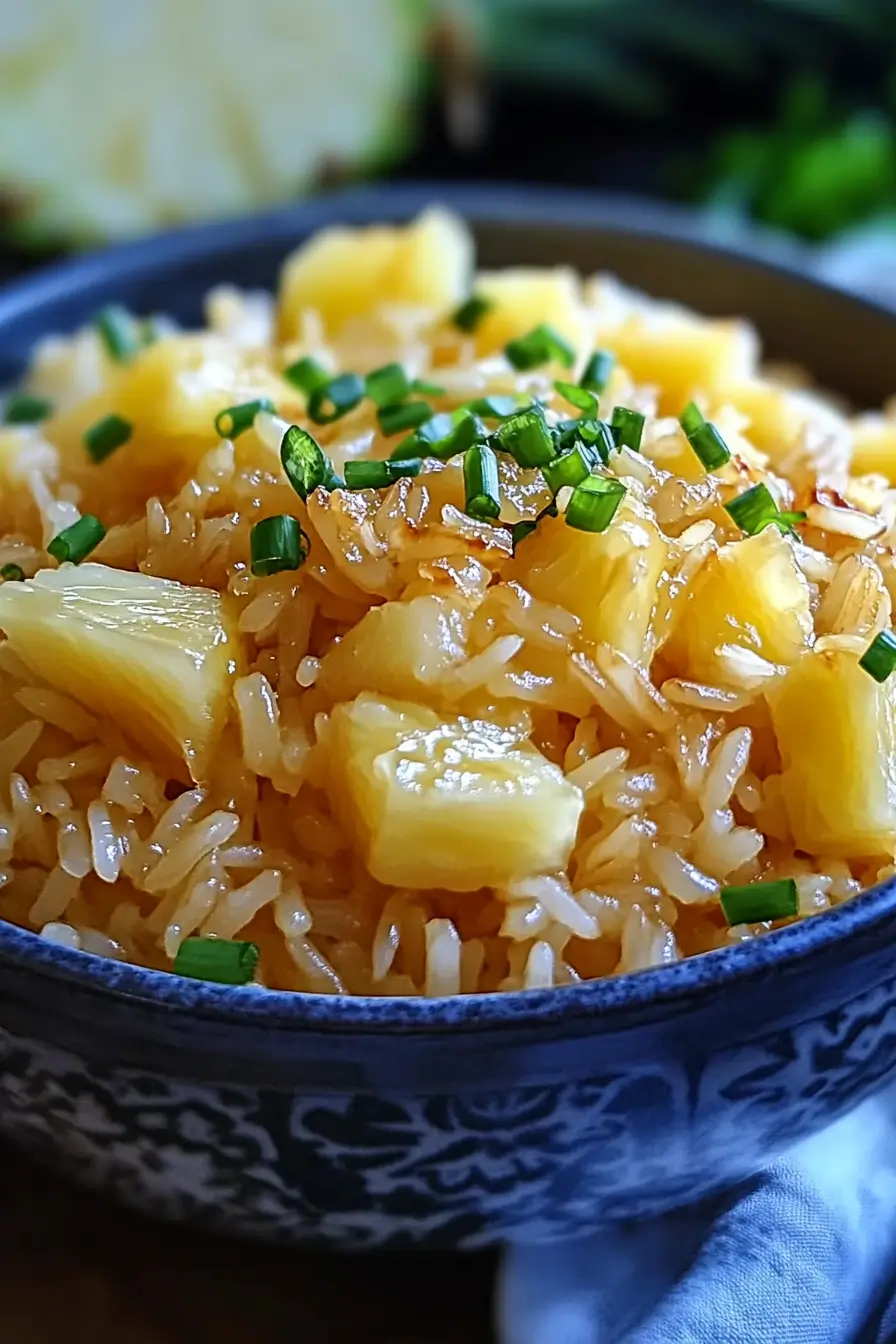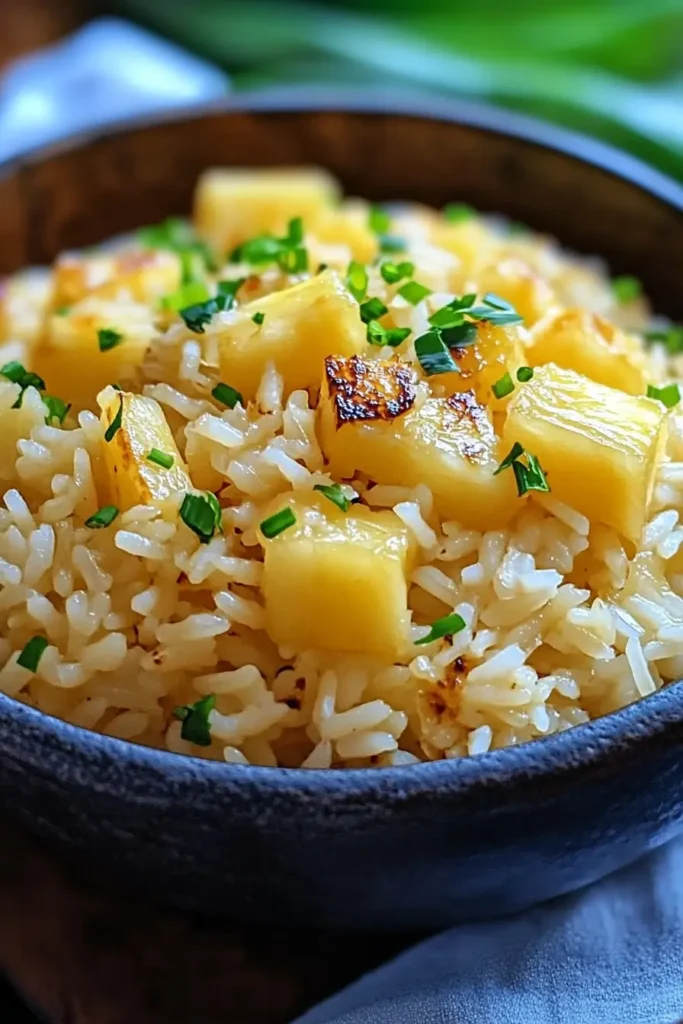Introduction
The Sweet and Savory Balance of Sticky Pineapple Rice
Sticky Pineapple Rice is a unique dish that brings together the sweetness of pineapple with the soft, chewy texture of sticky rice. This delightful combination creates a versatile meal that can be enjoyed as a side dish, main course, or even a dessert. The dish is a staple in many Asian cuisines, celebrated for its balanced flavors and ability to cater to diverse palates. Sticky rice, also known as glutinous rice, has a natural ability to absorb the flavors of the accompanying ingredients, making it an ideal base for this dish. Pineapple adds a tropical touch, while soy sauce and sesame oil bring depth and savory notes.
What sets Sticky Pineapple Rice apart is its adaptability. It can be customized with additional proteins like shrimp or chicken for a hearty meal or enhanced with coconut milk and nuts for a dessert-like twist. This recipe is also a great introduction to cooking with sticky rice, as the steps are straightforward and beginner-friendly. Sticky Pineapple Rice is a visually appealing dish, with its vibrant yellow pineapple chunks and the sheen of perfectly cooked rice. To explore more flavorful dishes, consider pairing this recipe with Loaded Baked Nachos for a unique dining experience.
What You’ll Need
Must-Have Tools for Perfect Sticky Rice
Creating Sticky Pineapple Rice requires a few essential tools that ensure the best results. First, a rice cooker or steamer is crucial for cooking sticky rice to perfection. Unlike regular rice, sticky rice requires precise moisture levels and even cooking, which these appliances provide. If you don’t own one, a stovetop steamer can also work, but it requires close attention to avoid overcooking. A large wok or skillet is equally important for combining the ingredients. The wide surface area allows for even cooking and ensures that the pineapple, rice, and seasonings are well-integrated.
In addition to these, a sharp knife and cutting board are necessary for chopping pineapples and garnishes like green onions. Using fresh ingredients is key to bringing out the vibrant flavors of this dish, and proper tools make preparation easier. You may also want a spatula or wooden spoon for stirring the rice mixture without breaking its delicate grains. Finally, small bowls for prepping ingredients ahead of time can streamline the cooking process, allowing you to focus on timing and flavor balance. For more ideas on essential tools for similar recipes, explore Cabbage Roll Casserole. With these tools on hand, you’re ready to create a dish that is both delicious and visually stunning.
Ingredients
Complete Ingredient List
Sticky Pineapple Rice uses a blend of simple yet flavorful ingredients that come together harmoniously. The first and most important ingredient is sticky rice, also known as glutinous rice, which is the base of this dish. Its soft, chewy texture makes it perfect for absorbing the sweet and savory flavors of the other ingredients. You’ll need 2 cups of sticky rice, which should be rinsed and soaked for several hours before cooking. Fresh pineapple is another star ingredient, with 1 ½ cups of pineapple chunks providing a burst of natural sweetness and a tropical aroma.
To add savory depth to the dish, you’ll need 2 tablespoons of soy sauce and 1 tablespoon of sesame oil. These ingredients not only enhance the flavor but also give the rice a glossy, appetizing appearance. Aromatics like 1 small onion (finely chopped) and 2 cloves of garlic (minced) form the base of the dish, offering a fragrant and savory foundation. For added texture, you can include ½ cup of roasted cashews, though this is optional. Finally, garnish the dish with green onions for a fresh, crisp finish and season with salt to taste.
Each ingredient plays a vital role in creating a balance of flavors and textures, making this dish a delightful culinary experience. For more inspiration on ingredient combinations, check out recipes like Crack Chicken Tenders or Baked Cranberry Cream Cheese Dip. These recipes, like Sticky Pineapple Rice, rely on simple yet flavorful ingredients that elevate the dish to restaurant-quality.
Instructions
Preparing the Sticky Rice
Perfectly cooked sticky rice is the foundation of Sticky Pineapple Rice, and getting it right is crucial. Start by rinsing 2 cups of sticky rice under cold water. This step removes excess starch, which can make the rice overly gummy. Once rinsed, soak the rice in water for at least 4-6 hours, though overnight soaking yields the best results. The soaking process allows the rice to absorb water evenly, ensuring a tender, chewy texture once cooked.
After soaking, cook the rice using a rice cooker or steamer. Follow the manufacturer’s instructions for sticky rice, as it requires precise water-to-rice ratios. If you’re using a stovetop steamer, line the steamer basket with cheesecloth or banana leaves to prevent sticking. Steam the rice for about 20-25 minutes, checking periodically to ensure it’s cooked through. The rice should be soft and sticky but not mushy.
Once the rice is ready, fluff it gently with a fork to release excess steam. This helps maintain the ideal texture and prevents clumping. Preparing sticky rice properly is a skill that enhances many dishes, much like techniques used in recipes such as Stuffed Potato Cakes. When your sticky rice is cooked to perfection, you’re ready to move on to creating the flavorful pineapple mixture.
Cooking the Pineapple Mixture
The pineapple mixture is where Sticky Pineapple Rice gets its signature sweet and savory flavor. Start by heating 1 tablespoon of sesame oil in a large wok or skillet over medium heat. Once the oil is hot, add 1 small onion (finely chopped) and 2 cloves of minced garlic. Sauté these aromatics until they become fragrant and slightly translucent, which takes about 2-3 minutes. The aroma of garlic and onion will create a savory base for the dish.
Next, stir in 1 ½ cups of pineapple chunks. Allow the pineapple to cook for 5-7 minutes, stirring occasionally. The heat will caramelize the natural sugars in the pineapple, enhancing its sweetness and giving it a slight golden-brown color. This step is essential for balancing the dish’s flavor profile. After the pineapple has softened and caramelized, add 2 tablespoons of soy sauce to the mixture. Stir well to coat the pineapple and aromatics evenly.
At this stage, you can add optional ingredients like ½ cup of roasted cashews for added crunch and nuttiness. Adjust the seasoning with a pinch of salt, depending on your taste. The pineapple mixture should be savory, sweet, and aromatic, creating a flavorful base for the sticky rice. For more ideas on creating balanced flavor combinations, refer to recipes like Cheesy Garlic Chicken Wraps. Once the pineapple mixture is ready, it’s time to combine it with the sticky rice.
Nutrition Score
Nutritional Benefits of Sticky Pineapple Rice
Sticky Pineapple Rice is not only a flavorful dish but also a source of essential nutrients. The primary ingredient, sticky rice, is rich in carbohydrates, making it an excellent energy booster. Each serving provides approximately 250-300 calories, depending on the portion size. Carbohydrates from the rice are ideal for providing sustained energy, especially when paired with the natural sugars found in pineapple. Pineapple chunks, a key ingredient, are packed with Vitamin C, which helps boost immunity and improve skin health. Pineapple also contains bromelain, an enzyme known for its anti-inflammatory and digestive benefits.
The use of sesame oil in this recipe introduces healthy fats, which are beneficial for heart health and add richness to the dish. Soy sauce adds a touch of sodium, enhancing the flavor while contributing to electrolyte balance. For those who include roasted cashews, the dish gains a boost of plant-based protein and additional healthy fats. Cashews also provide magnesium and zinc, essential minerals for overall wellness.
When paired with complementary side dishes like Roasted Cranberry Goat Cheese Flatbread or Caramelized Butternut Squash, Sticky Pineapple Rice becomes a well-rounded meal. Its balance of carbohydrates, vitamins, and fats ensures a dish that is not just satisfying but also nutritious.
Serving & Storage
How to Serve Sticky Pineapple Rice
Sticky Pineapple Rice can be served in various ways, making it suitable for any occasion. One of the most popular serving options is as a main dish, especially for vegetarian meals. Pair it with steamed or stir-fried vegetables to add more color and nutrition to your plate. The sweet and savory balance of this dish makes it a perfect standalone meal. For those who prefer a protein boost, consider serving it alongside grilled chicken, fish, or tofu, as these proteins complement the tropical and umami flavors beautifully.
Another creative way to serve Sticky Pineapple Rice is inside a hollowed-out pineapple shell. This presentation not only enhances the tropical vibe but also makes for an Instagram-worthy meal. If you’re hosting a dinner party, this presentation is sure to impress your guests. Additionally, Sticky Pineapple Rice pairs wonderfully with Asian-inspired appetizers like Baked Chicken Taquitos or Crockpot Steak Bites.
Proper Storage Tips
Leftovers can be stored and enjoyed later with minimal effort. Place the rice in an airtight container and store it in the refrigerator for up to 3 days. To prevent the rice from drying out, cover the top with plastic wrap before sealing the container. For long-term storage, Sticky Pineapple Rice can be frozen for up to one month. When reheating, add a splash of water to restore the moisture lost during storage. Use a stovetop or microwave to reheat gently, ensuring the rice doesn’t overcook.
Variations
Sweet Sticky Pineapple Rice
For a dessert-like version, transform Sticky Pineapple Rice into a sweeter treat by incorporating coconut milk during the cooking process. The coconut milk not only adds creaminess but also enhances the tropical flavor profile. To elevate the dessert aspect further, sprinkle toasted coconut flakes and a drizzle of honey or maple syrup before serving. Adding dried fruits like raisins or cranberries can provide bursts of sweetness, complementing the pineapple perfectly. This variation is reminiscent of tropical desserts and pairs beautifully with recipes like Baked Cranberry Cream Cheese Dip.
Savory Pineapple Rice
If you prefer a more savory version, consider adding diced vegetables such as bell peppers, peas, or carrots to the dish. These vegetables enhance the nutritional value while adding vibrant colors. For a protein-rich variation, stir in shrimp, chicken, or tofu, seasoning them with soy sauce and a pinch of black pepper for added flavor. A dash of chili flakes or Sriracha can provide a spicy kick, balancing the sweetness of the pineapple. This savory variation is perfect for a hearty meal and pairs well with side dishes like Cheesy Garlic Chicken Wraps.

FAQs
What is the secret to sticky rice?
The secret to perfect sticky rice lies in two key steps: soaking and steaming. Soaking the rice for 4-6 hours (or overnight) allows the grains to absorb water evenly, ensuring a tender and chewy texture. Using a rice cooker or steamer specifically designed for sticky rice is also crucial. Additionally, selecting the right type of rice, such as glutinous rice, ensures the grains have the proper starch content to create the characteristic stickiness.
What is pineapple fried rice made of?
Pineapple fried rice is typically made with sticky rice or jasmine rice, fresh pineapple chunks, soy sauce, sesame oil, and aromatics like garlic and onion. Some versions include proteins such as shrimp, chicken, or tofu, and additional vegetables like peas or bell peppers. The dish balances sweet, savory, and tangy flavors, making it a versatile option for various meals.
Why do Chinese eat sticky rice?
Sticky rice holds cultural and culinary significance in Chinese cuisine. It is often used in festive dishes, such as zongzi (sticky rice dumplings), because of its symbolism of unity and togetherness. The unique texture of sticky rice makes it a favorite for both savory and sweet dishes. Its versatility and satisfying chewiness have made it a staple in many Chinese households.
What makes sticky rice different?
Sticky rice is different from regular rice due to its high amylopectin content, a type of starch responsible for its sticky texture. Unlike other rice varieties, sticky rice does not contain amylose, which contributes to the dryness of standard rice grains. This unique composition makes sticky rice chewy, cohesive, and perfect for absorbing flavors, setting it apart from other rice types.
Conclusion
Sticky Pineapple Rice is a delightful dish that blends tropical sweetness with savory flavors, creating a versatile meal suitable for any occasion. Its unique combination of sticky rice, fresh pineapple, and savory seasonings offers a balance of textures and tastes that’s hard to resist. Whether served as a main dish, side, or even dessert, it’s sure to impress your family and guests. With simple ingredients and easy preparation, this dish is perfect for beginners and seasoned cooks alike. Pair it with recipes like Roasted Cranberry Goat Cheese Flatbread for a complete dining experience. Enjoy every bite!


